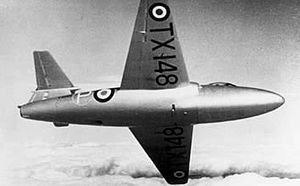Gloster E.1/44 Video - History of Gloster Aircraft Company
|
|
Gloster E.1/44

Picture - TX148, the third prototype on a test flight, c. 1949
Role: Fighter
Manufacturer: Gloster Aircraft Company
Designed by: George Carter
First flight: 9 March 1948
Retired: Cancelled
Primary user: Royal Air Force (intended)
Number built: 3 (4th prototype not completed)
The Gloster E.1/44 was a British single engined jet fighter design of the Second World War which came about because of low availability of jet engines but was not completed in prototype form until after the war and never entered production.
Design and development
The success of the first British jet aircraft the Gloster E.28/39 led to the design of the twin engined Gloster Meteor jet fighter from 1940 onwards. However in 1942 Rover, who were contracted to produce the Whittle W2 jet engine, were having production problems so the Air Ministry issued a Specification, E.5/42, asking for a design which would use only one engine rather than the two. Gloster produced a design for a low winged monoplane with a highly tapered wing and a T-tail, to be fitted with a tailwheel undercarriage. It was to be powered by a single Halford H.1 or Rolls-Royce Nene engine fed by intakes in the wing roots. Construction began of two E5/42 prototypes began late in 1943. In the end Rolls-Royce Limited traded jet engine production (the W2 would become known as the Welland) for tank engine production with Rover; the supply problem was resolved and the single engined design was not required. Gloster continued with their design work privately intending to use a Halford H.1 engine instead of the W2/Welland.
In 1944 the Ministry issued a Specification, E.1/44, for an experimental jet aircraft using the new Rolls Royce Nene engine. Gloster's design to meet this specification was a new design (GA.2), not based on the E5/42, being significantly larger. Gloster received a contract to build a single prototype, in 1944, with orders for a further three aircraft following in late 1945.

Picture - Gloster E.1/44 SM809 with original tail unit c. 1944

Picture - Gloster E.1/44 TX145 with modified tail unit
The new design was a stressed-skin mid-winged monoplane with, unlike the E5/42, a tricycle landing gear. The tailplane was mounted midway up the rear fuselage, behind the single fin and rudder. The engine was fed from semi-circular intakes ahead of the wing roots, while the wings were, unusually, skinned in difficult to work stainless-steel.
Operational history
Testing and evaluation
Progress on the new fighter was slow, with Gloster concentrating on development of the Meteor. The first prototype was not completed until July 1947, and was destroyed in a road accident when being taken to Boscombe Down for flight testing.
The first E.1/44 to fly (the seond prototype) did so on 9 March 1948 flown by Gloster Chief Test Pilot Bill Waterton who was definitely not impressed with its lack of power or poor flying characteristics, dubbing it the "Gormless". The unofficial name never stuck and the prototype did not have an official name, although "Ace" was proposed.
Handling was initially poor, with a new tail unit, with a high mounted tailplane being fitted. While this solved the handling problems, performance was still little better than that of the Meteor, and the programme was stopped in 1949 as the aircraft did not have the development potential of the Meteor, with the fourth prototype (TX150) not completed. The revised E.1/44 tail design was, however, carried over to the Meteor, and employed on the Meteor F 8 and later models. The only two aircraft to fly were used as testbeds for a while before being scrapped, one remaining in use until at least 1951.
Specifications (E.1/44)
Data from The British Fighter since 1912
General characteristics
Length: 38 ft 0 in (11.59 m)
Wingspan: 36 ft 0 in (10.98 m)
Height: 11 ft 8 in (3.56 m)
Wing area: 254 ft² (23.6 m²)
Empty weight: 8,260 lb (3,755 kg)
Loaded weight: 11,470 lb (5,214 kg)
Powerplant: 1x— Rolls-Royce Nene II centrifugal flow turbojet, 5,000 lbf (22.3 kN)
Performance
Maximum speed: 539 knots (620 mph, 998 km/h)
Range: 357 nm (410 mi, 660 km)
Service ceiling: 44,000 ft (13,400 m)
Climb to 40,000 ft (12,200 m): 12 min 30 sec
Armament
Guns: 4 x 20 mm Hispano cannon
Comparable aircraft
Supermarine Attacker
Hawker Sea Hawk
Bibliography
Ashley, Glenn. Meteor in Action. Carrollton, Texas: Squadron/Signal Publications Inc., 1995. ISBN 0-89747-332-9.
Bowyer, Chaz. Gloster Meteor. London: Ian Allen Ltd., 1985. ISBN 0-7110-1477-9.
Buttler, Tony. Gloster Meteor (Warpaint Series No.22). Milton Keynes, Buckinghamshire, United Kingdom: Hall Park Books Ltd., 2001. ISBN 1-85780-230-6.
Caruana, Richard J. and Richard A. Franks. The Gloster & AW Meteor. Kingsway, Bedford, United Kingdom: SAM Publications, 2004. ISBN 0-9533465-8-7.
Goulding, James. Interceptor: RAF Single-Seat Multi-Gun Fighters. London: Ian Allen, 1986. ISBN 0-7110-1583-X.
Green, William and Gordon Swanborough. The Great Book of Fighters. St. Paul, Minnesota: MBI Publishing, 2001. ISBN 0-7603-1194-3.
James, Derek N. Gloster Aircraft since 1917. London: Putnam, 1971. ISBN 0-370-00084-6.
Jones, Barry. Gloster Meteor. Ramsbury, Marlborough, Wiltshire, United Kingdom: The Crowood Press Ltd., 1998. ISBN 1-86126-162-4.
Mason, Francis K. The British Fighter since 1912. Annapolis, Maryland: Naval Institute Press, 1992. ISBN 1-55750-082-7.
Waterton, W.A. The Quick and the Dead: The Story of a Chief Test Pilot. London: Muller, 1956.
Living Warbirds: The best warbirds DVD series.
Source: WikiPedia